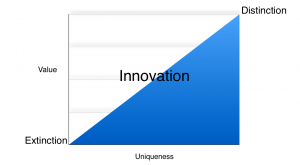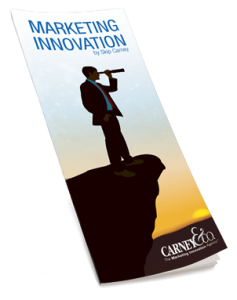Tag: marketing innovation
 The Unique Selling Proposition was the golden rule of advertising for decades, and no matter how much lip service is given to the value proposition and other strategies, the mindset of the USP is still there. It’s time to lay it to rest.
The Unique Selling Proposition was the golden rule of advertising for decades, and no matter how much lip service is given to the value proposition and other strategies, the mindset of the USP is still there. It’s time to lay it to rest.
(more…)
When I discuss Marketing Innovation, one-on-one or with a group of 250, I always tell the story of the drill bit. It goes like this: You walk into Lowe’s to get a half inch drill bit. Six dollars later, you have your drill bit. But you didn’t go to Lowe’s because you wanted to add to your drill bit collection. You went because you wanted a half inch hole. It’s the hole that was worth $6. The bit was just a means to an end. (more…)
Innovation guru Doug Hall says that every business, every product, every service is on a continuum somewhere between Monopoly and Commodity. At one end, you own the market (for the moment) and at the other, you compete with the rest of the commodities. I think it is the difference between Distinction and Extinction. At the Distinction end of the spectrum, sales, margins, profits, market share and brand recognition are all high. At the other end, the opposite is true and when you compete on price, you never win long term. For the record, WalMart does NOT compete on price.* But that’s another post for another day.
Innovation is the difference.
Companies that offer true innovation offer unique solutions to customer problems, provide real value, and raise the bar for their industry. Innovation comes in all shapes and sizes. Some are stepping stones to larger innovations. Some (like the mouse, the mp3 player, and the touch screen) go unrealized until someone like Steve Jobs comes along. It’s not the size of the innovation that matters, it’s the relentless pursuit of innovation and the marketing of that innovation that yields results.
* A 2012 study by Bloomberg Industries showed that Target, Aldi, even Kroger, had better prices on many products.
I love Bose. The company produces amazing sound and long ago set the standard for innovation and quality in the world of audio. I love my Wave Radio so much I sent Paul Harvey a letter about it. He read it on his show for over three years.
So when it came time to replace my surround sound system with a sound bar, I naturally wanted a Bose Sound Bar.
I got one, installed it and, of course, loved the sound. The problem was to play music, I had to have my TV on. So, I looked for other options and found my way eventually to Sonos. The Sonos system does NOT sound as good as Bose, but I’m the only one in the house that knows that. Sonos has developed an interface, however that is easy to use, works from my iPhone and iPad, and allows me infinite control over each component without engaging my TV. I am confident Bose is working on a similar system. Unfortunately, it’s too late for me. I have moved on. That’s the way of the world today. When we want it, we want it now. For today, Sonos innovation beats Bose brand. The ball is now in Bose’s court. Meanwhile, their brand and sales are taking the hit.
Marketing is not just about growing. It is also about choice. Sure you want to give your customers choices, but you also want to be able to choose your customers. If you have a steady flow of inquiries and leads, you have more control over the kind of business you take. This is especially true for B2B companies, but it also applies to B2C. Retail and consumer marketers discriminate with price and distribution. Business to business marketers can discriminate with price, type of project, and by sometimes just saying, “No, we don’t think this would be a good fit.”
You can only say “no,” though, when you have options, and the best way to have options is by keeping your message in front of your customers and prospects. This is why the best companies never let their foot off the gas of their marketing or their innovation. Innovation gives you a reason to market and a message that connects. Marketing that innovation communicates value and distinction. When you have that, you can say “yes” to the customers and business that you really want and “no” to the business that isn’t profitable or otherwise doesn’t fit.
Innovation is the buzzword of the century and, while it is laudable to want to be like Apple or Amazon, it’s hardly necessary to reinvent your industry to find success. It IS necessary to market innovation.
Why marketing innovation works.
Simply put, innovation is a creative solution to a customer problem. Big problems, little problems, everybody has them and they all need solutions. Every business is capable of this kind of innovation and most are innovating every day. They just fail to realize or act on that innovation and most importantly, they fail to market it.
Customers want more than just solutions to their problems, they want NEW solutions. They will ALWAYS want new solutions. Tide laundry detergent has been “new and improved” more than 80 times in the past 75 years. Most of those innovations were not earth shattering, but they were significant enough that Tide has maintained its dominance in its category. Look around your company. You have innovation opportunities everywhere. Solve your customers’ problems and then tell them about it. Your brand, market share, sales growth, and profit margin will all follow.





